Editorial
The move to a new host has not yet transpired, but I'm hopeful it will take place in the first week of February. The current host does not seem very interested in upgrading hardware to match the traffic volume of all the web sites their servers host. This impacts your page load wait time along with my email connectivity, the latter best being described as abysmal! MEN broke the 15GB download barrier in January with over 14,000 unique visitors and 1.5 million "hits". DVD sales for the month were good too, so we live a while longer.
As expected, January here was a scorcher with a few damaging storms that dumped everywhere but the reservoir catchment areas. Our state Governor (we call them Premiers) has cancelled the planned March referendum that was to have asked the residents of the state their view on having purified waste water mixed back into the drinking supply—he's just going to do it without risking, err, seeking the will of the people first. Given how a similar referendum in a nearby town called Toowomba (pronounced 2-woom-ba) was hijacked by political factions and scare mongers, I'd say he's made the right, if difficult and possibly unpopular choice. After purification, the water will probably be more pure that that it is mixing with. The way I see it, there is no practical alternative and I wonder how much longer it will be before other major Australian population centers follow his lead. And I'm sure it will have no significant impact on my mixture of Cool-Tool cutting fluid either (he says in a desperate attempt to inject some model engineering back into the conversation).
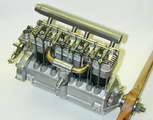 Yes, that's a fully assembled Cirrus Mk I. Too bad it's going to have to be taken apart one more time. The trial assembly uncovered an unexpected binding at one of the two TDC positions. This was tricky to track down. Turns out that one side of one conrod was just brushing the lip of the its cylinder skirt as it swung into the TDC position (the rod ends are wide because of the big-end caps). The cure was some subtle grinding on the lower skirt, so there are metal particles that need to be cleaned away before I can think about a test stand. I've lived with the thing for so long now that it's just a good looking engine, but club members seeing it on the occasion of the first public viewing since assembly seemed rapturous. Goes to show what familiarity does. One of the last jobs required making a punch and die to produce the head gaskets. After a bit of a learning curve, this worked very well and should be documented next month as a tech tip.
Yes, that's a fully assembled Cirrus Mk I. Too bad it's going to have to be taken apart one more time. The trial assembly uncovered an unexpected binding at one of the two TDC positions. This was tricky to track down. Turns out that one side of one conrod was just brushing the lip of the its cylinder skirt as it swung into the TDC position (the rod ends are wide because of the big-end caps). The cure was some subtle grinding on the lower skirt, so there are metal particles that need to be cleaned away before I can think about a test stand. I've lived with the thing for so long now that it's just a good looking engine, but club members seeing it on the occasion of the first public viewing since assembly seemed rapturous. Goes to show what familiarity does. One of the last jobs required making a punch and die to produce the head gaskets. After a bit of a learning curve, this worked very well and should be documented next month as a tech tip.
The Engines of Michel Arseneau
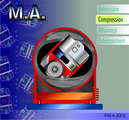
You may remember the unusual engines designed by Canadian, Michel Arseneau that were added to Page 9 of the Gallery for the MEN January 2007 issue. In the past month, Michel has worked as hard on getting his own web site on-line as he has on his engines. The result is a very professional presentation that shows pictures of all his designs with some internal details of one of the designs that we are now able to talk about a bit more. I hinted rather obliquely that Michel had combined two "old" engine technologies. Now it can be told: take the opposed piston concept as used in the Junkers 250D "Jumo" and the Napier Deltic, then spin the cylinder and actuate the pistons via rollers in place of conrods that run on an oval cam track. Visit Michel's web site for more details.
London Model Engineering Show, 2007
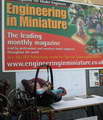
Hot on the heals of Model Engineer's postponed annual exhibition came the 2007 London Model Engineering Exhibition sponsored by rival publication, Engineering in Miniature. MEN's roving reporter, John Downie, reported that IC activity was rather low, but we have pictures of what there was on show—even if we've seen them before on these pages. For an explanation of why the lead photograph for the Exhibition does not seem to be about to internally combust, see the London 2007 ME Exhibition page.
Readers may recall that Model Engineer had to postpone their show at the last minute, as we reported in the December Editorial Page. The ME's IC contributing editor, Nemett, has emailed with hot-off-the-press news. The revised date and venue for the ME exhibition is September 7-9, at the Ascot Racecourse in Berkshire. Mark your calendars appropriately.
Seal Problem
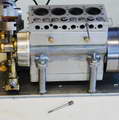
Just because a design has been around for a while and comes from a respected designer, don't assume all the bugs have been worked out. As we've mentioned more than once in the past months, the ETW Seal first appeared in 1947. An engine built to those drawings will have a problem as two of the manifold attach screw holes intersect with two of the head attach screw holes with not a lot of meat left between them. The drawings have never been corrected and if any warnings were ever published about this problem, they have been lost in the mists of time. This photo shows one builder's solution: the manifold screw holes are drilled out to take a stepped stud. After this is screwed in place, the offending head stud hole is extended through the enlarged part of the stepped stud, then tapped for the standard head stud. Everybody is then happy and the danger of stripping threads due to a short engagement length is avoided.
Modern Combat Technology
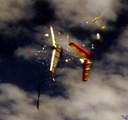
Another new link this month goes to a site dedicated to control line combat flying. As well as good general coverage of this very exciting event in all its various guises, the site has a nicely presented review of the Cyclon PC6 F2D combat engine that employs an aluminum liner with a ceramic coated piston. The smaller Cyclon is also the engine for F1J free flight models. Well worth a look.
Stewed Crow on Toast
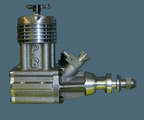
It's been a while since I've had to dine on crow (a raucous, protected, yet plague proportion species here downunder, damnit), but I must sharpen up the gnashers because last month I said that the Front Rotary Bugl made by Luis Petersen was unique. That was my assumption, not anything Luis actually said and turns out to be rather incorrect. Here is yet another, one of a pair from Bugl himself at that. Boring a case to achieve precisely the correct fit for a ball race in a high-performance engine is a rather critical operation, especially when the case material is aluminum (see the FMV Story for a less critical alternative). Luis says they found a use for crankcases rejected because of oversize recesses: cut off the front and fit a sand cast FR housing! So now we know of three. The one Luis built, the one pictured here, and another being used in a combat trainer!
New Books and Magazines This Month

Issue #8 of Model Engine Builder arrived during January. This one completes the Hamilton Upshr opposed twin "farm engine" begun in the previous issue. The center spread features Barrington Hares' Eagle 22 with photographs taken by editor Mike Rehmus on he trip to Jolly Olde England last year. There are lots of engine building tips and another description of an unusual engine design. This has become a regular feature and each engine described is accompanied by a CAD drawing of the pertinent parts of the design. You could not build from these (ok, maybe Tom Pascoe could), but they are a big step up from words and photographs. As usual, if you don't subscribe, you should— and not just because a couple of articles from yours truly are schedules for forthcoming issues.
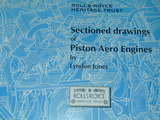
Let me go out on a limb and say without a shred of evidence that model engineers find sectioned drawings of mechanical things irresistible and probably did long before they became model engineers. I fondly recall the drawing that graced the center page of Eagle back in the 1950's and the beautifully drawn and indexed drawings of Flight and The Aeroplane. The book this month is a collection of 36 such drawing sets by Lyndon Jones. Unlike the Flight drawings, those in this book have been produced not for commercial application, but just out of Jones' love for the subject matter. The book is titled Sectioned drawings of Piston Aero Engines. It is published by the Rolls Royce Heritage Trust, PO Box 31, Derby, England. The ISBN is 1-872922-07-4. It is a large, spiral bound book with soft covers and 80 pages 11.5" x 16" (29.2 cm x 40.64 cm).
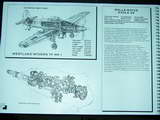 As a publication of the Rolls-Royce Heritage Trust, we could expect it to be constrained to Rolls-Royce engines, and it is. Fortunately for variety, RR has, over the years, absorbed many other engine manufacturers, so the book contains seventeen RR designs like the Merlin, Vulture, Eagle(s), etc, plus engines from DeHavilland, Bristol, Armstrong Siddley, Napier, Junkers and BMW! Each engine gets two pages. On the right is the sectioned engine while the facing left hand page carries some text and associated drawings relating to the engine. These might be sectioned airframes that carried the engine in question, or "scrap" views of some aspect of the engine. The shot here is the facing page for the Rolls-Royce Eagle 22 showing the shaft arrangement and the Westland Wyvern that was originally powered by this engine before converting to turbo-prop.
As a publication of the Rolls-Royce Heritage Trust, we could expect it to be constrained to Rolls-Royce engines, and it is. Fortunately for variety, RR has, over the years, absorbed many other engine manufacturers, so the book contains seventeen RR designs like the Merlin, Vulture, Eagle(s), etc, plus engines from DeHavilland, Bristol, Armstrong Siddley, Napier, Junkers and BMW! Each engine gets two pages. On the right is the sectioned engine while the facing left hand page carries some text and associated drawings relating to the engine. These might be sectioned airframes that carried the engine in question, or "scrap" views of some aspect of the engine. The shot here is the facing page for the Rolls-Royce Eagle 22 showing the shaft arrangement and the Westland Wyvern that was originally powered by this engine before converting to turbo-prop.
I've forgotten what I paid for this book, but it was not a lot, and members of the Rolls-Royce Heritage Trust get a healthy discount. Recommended for everyone who loves aero engines, or sectional drawings.
Engine Of The Month: David Stanger's Engines

The unexpected arrival of photographs showing the V-twin and V-four cylinder engines designed and build by David Stanger at the dawn of aviation prompted a tribute page to this nearly forgotten pioneer. You can click the photo, use the "People|Pioneers" menu item of the Nav-bar, or just click here to read about his accomplishments. Thanks go to Tim Westcott (FRAeS) for the material. Tim is now the custodian of the historical Geenhalgh collection which includes the Fairy Queen shown on page 8 of the Engine Gallery.
Tech Tip of the Month

The EDM How-to page has proven very popular with over 1200 unique visitors during the first three weeks since it went on-line. An email from Nick Jones relates how he has used his to remove a sheared stud in his Sidel five cylinder radial and a rather unexpected problem he encountered in the process. The E of EDM stands for electrical, but as Nick discovered, a stud that has been inserted with thread-locking compound just may end up effectively insulated from the surrounding metal making the circuit required to sustain the spark impossible to achieve. The solution will be different in each case, but EDM'ers should take note. Another "gotcha" with more pictures has been added to Page 6 of the EDM How-to section.
In the EDM Introduction, eight ways of removing broken taps are listed, one of which is chemical erosion using acid. During the past month, I received and email from Jerry Howell giving details of another chemical erosion method that does not involve strong acids. I've not tried this, but the source credentials are of the highest quality (visit Jerry's web site to see why). Here is his text:
Removing broken drills or taps from non ferrous metals such as Aluminum, Brass etc.
At most any grocery store, buy a box of alum (aluminum sulphate). Select a glass or ceramic container (made for stove top use) or an aluminum pot large enough to place your part in so that it can be submerged in water. Remove the part and bring the water up to just below the boiling point of the water. Add alum until no more will dissolve, then place your part in the solution. Keep the solution at a simmer and you will soon observe a trail of tiny bubbles coming from the broken drill/tap. Keep the solution at a simmer and add water as needed as long as the trail of bubbles continue. When the bubbles stop, remove the part and let cool for inspection. You should discover that the steel drill or tap has turned to a rusty mud which is easily removed from the hole. Depending on hole depth, amount of steel to be removed, etc., this process can take from an hour or so to the biggest part of the day, but it works great.
Regards,
Jerry E. Howell
New Gallery Page
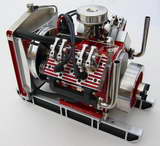
As well as the tip on chemical erosion of steel in aluminum, Jerry Howell sent in some photos of his fantastic V4. Other photos received included rare shots of the engine part of an ETW Road Roller engine, and a scaled-up ETW Sealion (which itself is a scaled up Seal). All of these justified a New Gallery Page and a revision to make the Gallery Index a bit more readable. The web stats show that The Gallery and the Watzits are the most consistently popular pages. Sorry to say, no new Watzit this month.
More Tinkering Around the Edges

A lot of revision and augmentation has gone into site navigation in the past month. Last month, new Nav-bar items were added to index all the existing and new web pages alphabetically. This month, we add a structured map of the site. Click on the "Site Map" menu item, then select Structured Map item. I don't know if it's of any use to you, but it sure is to me!
I now have a pretty heavy duty set of automated processes that are run at the end of the month to re-generate the Links page, the Suppliers Index page, the Site Map, and both the alphabetical index pages. Part of this process performs link validation. To my shame, the process did find quite a few, so MEN Members will find a download that fixes all the pages with broken links on the Downloads page. Optionally, this link check goes out to the web and validates links to pages on other sites. Sadly, a number of old favorites have gone 404 on us (the HTTP error number for site unreachable). Where I can find a new web address, I'll fix the link, but I've decided not to go back and remove these dead links. The fact that there once was a link is part of the information content, plus the process is tedious. Sorry (no I'm not  ).
).
KEO Goes 404
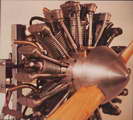
One of the sites that I've sadly removed from the links and suppliers page is KEO Engines. This site was the source for the Wright J-5 Whirlwind castings and others (see the June 2005 page). This engine had been on my "must get a set of castings for Under The Bench" list. Moral: don't wait, do it now! Despite a spirited Google search, I could not locate an alternate URL, so if anyone knows whether these and the others are still available, I'd sure appreciate an email so I can revise all the links.
The Missing Link
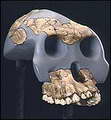
The Links Page has had a serious overhaul. Previously, link entries were held in a spreadsheet which had to be exported as a comma separated variable (csv) file before the page could be generated. As part of my personal "Microsoft: just say no" program, the data are now held as XML. This makes maintenance and page generation much easier. I was happy with the earlier links page layout, so it has not changed. New links are flagged  and all automatically open in new browser pages, or tabs if your browser supports them. A new section has been added that contains links to web sites featuring unusual engines. All entries in this section are flagged new even though I may have mentioned them before in these pages. Next month, the new will icon will disappear, unless there are actual new entries for the month.
and all automatically open in new browser pages, or tabs if your browser supports them. A new section has been added that contains links to web sites featuring unusual engines. All entries in this section are flagged new even though I may have mentioned them before in these pages. Next month, the new will icon will disappear, unless there are actual new entries for the month.
 The Engines of Michel Arseneau
The Engines of Michel Arseneau
 London Model Engineering Show, 2007
London Model Engineering Show, 2007
 Seal Builders Beware
Seal Builders Beware
 Modern Combat Technology
Modern Combat Technology
 Stewed Crow on Toast
Stewed Crow on Toast
 More Tinkering Around the Edges
More Tinkering Around the Edges
 New Gallery Page
New Gallery Page
 KEO Goes 404
KEO Goes 404
 The Missing Link
The Missing Link
 Editorial
Editorial
 New Books and Magazines This Month
New Books and Magazines This Month
 Engine Of The Month: David Stanger's Engines
Engine Of The Month: David Stanger's Engines
 Tech Tip of the Month
Tech Tip of the Month
 Standard Stuff
Standard Stuff













 ).
).


 and all automatically open in new browser pages, or tabs if your browser supports them. A new section has been added that contains links to web sites featuring unusual engines. All entries in this section are flagged new even though I may have mentioned them before in these pages. Next month, the new will icon will disappear, unless there are actual new entries for the month.
and all automatically open in new browser pages, or tabs if your browser supports them. A new section has been added that contains links to web sites featuring unusual engines. All entries in this section are flagged new even though I may have mentioned them before in these pages. Next month, the new will icon will disappear, unless there are actual new entries for the month.